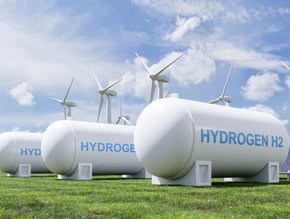Battery vs fuel-cell vehicles - friends or foes?

The global scarcity of resources has set a significant challenge against the development of sustainable technology in recent years – especially in the sustainable vehicle industry. As it becomes increasingly acknowledged that no technology alone can drive the sustainability movement onward, it looks more likely that the integration of battery and fuel-cell vehicles will be the best option for companies striving to achieve 100% decarbonisation.
According to leading circular materials technology company, Umicore, the most essential difference between batteries and fuel cells is that the former stores energy which it then uses, whereas the latter generates energy by converting available fuel. Therefore, fuel cells can produce power as long as there is access to fuel.
Interestingly, a fuel cell can also contain a battery component to store the energy it is generating. Although Umicore’s primary aim is to develop Proton Exchange Membrane (PEM) fuel cell catalysts, the company recognises the benefits of combining the two energy solutions to create electric powertrains that will tackle the clean energy challenge head on: “Both technologies will have their place as a hybrid solution. Depending on the application, either can be the best answer. It all depends on the needs, demands and conditions of its use.”
While it’s clear that battery vehicles have driven themselves to fame faster than hydrogen cars (especially in the world of passenger vehicles), the two aren’t actually totally pitted against one another. According to Global Spec, as more people begin to switch to clean energy solutions and automotive manufacturers are forced to meet demands for affordable, reliable and sustainable vehicles, it’s likely that hybrid models combining elements of batteries and fuel cells will emerge.
Are battery electrics or fuel-cell electrics the answer to a clean energy solution?
Many companies and individuals have favoured battery-electric cars for their renowned energy efficiency (since they reuse 80-90% of the energy stored inside), lower running costs and ease of charging. Tesla, for example, have crafted impressive manufacturing systems to produce high numbers of battery-electric vehicles within a single fleet. Their process of ‘gigacasting’ (producing one giant piece instead of lots of small pieces) has become renowned for the extent to which it reduces the cost and production time for a fleet of electric vehicles – thereby making battery-electric cars more affordable and accessible to a wider audience.
On the other hand, proponents of fuel-cell (or hydrogen) vehicles prefer their faster refuelling processes and longer driving range. While a battery-powered electric car requires hours of recharging time, a much larger trailer-truck will take only 15 minutes. For larger vehicles taking multiple rounds of trips in a day, then, fuel cells seem to be the sensible option. Since hydrogen has a higher energy density than batteries, a fuel-cell powertrain will weigh less and consequently allow its vehicle to travel for longer, while carrying heavier cargos.
Recently, green hydrogen mobility solutions company First Hydrogen partnered with fleet management company Rivus to assess the performance of its brand new hydrogen vehicle. Clearly, as hydrogen technologies develop, a range of corporations and their stakeholders are becoming interested in the capabilities of fuel-cell vehicles on a grander scale.
“[Rivus’s] findings will showcase our vehicle’s capabilities to a new audience of fleet customers and create market demand. Rivus’ input will help us to optimise performance and will also inform our plans for future vehicle development and deployment. The team’s expertise will also help us to support fleet operators to switch to zero-emission vehicles,” says Steve Gill, CEO Automotive at First Hydrogen.
Additionally, whereas the resources required to produce high amounts of lithium-ion batteries are currently in short supply, the production of fuel cells requires much more common materials (such as aluminium and stainless steel). This means that fuel-cell vehicles may seem like the better long-term option for supply chain sustainability.
Combining energy methods to produce a sustainable hybrid solution
Although both battery and fuel-cell solutions continue to face criticism for their inability to be completely carbon neutral (mainly due to the disposal of batteries and transportation of hydrogen), they both also produce no tailpipe emissions at all and are clearly kinder to the environment than traditional modes of transport.
Therefore, many vehicle manufacturers, researchers and consumers have started to recognise the potential that batteries and fuel cells have when their capabilities are put together to power electric vehicles.
“I think we will see in the next year that we will need both technologies,” Bernd Heid, McKinsey & Co Senior Partner, told Automotive News. “The interesting part is that it’s not only dependent on the propulsion technology of the powertrain, but it also has to do with the infrastructure. And we will see that two infrastructures will be cheaper to society than if we just do all-electric infrastructure.”
Jackie Birdsall, Senior Engineering Manager of Toyota’s Fuel Cell Integration Group, agreed: “Hydrogen and fuel cell electric vehicles are complementary. There’s two different use cases. Our job is to give these zero-emission technologies, to make them available to the customer, and then the customer can choose the application or the powertrain that best suits their lifestyle [and] that best suits their fleet’s needs.”
Heid and Birdsall argue that both battery-electric and fuel-cell electric vehicles will be needed to achieve global decarbonisation goals. Whereas batteries will likely remain known for their efficient reuse of energy and lower running cost, it’s also probable that fuel cells will become more popular as their capacity for faster refuelling and longer distances becomes more accessible, too – especially as companies like Umicore and First Hydrogen continue to research and experiment with new ways to use hydrogen as a source of clean energy.
Overall, a hybrid solution to the clean energy problem seems to be the best way forward. Since battery power and fuel-cell power each have their own benefits and drawbacks depending on the needs, demands and conditions of their use, perhaps it’s time for energy technology and automotive manufacturers to find new ways of combining these power sources.
If we are able to utilise and unite their strengths, it’s likely that the green energy movement will have more capacity to focus on the development of smarter driving solutions and improved operational management to improve the vehicle experience, too.







